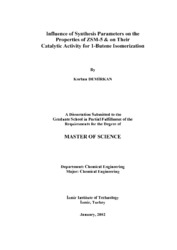Please use this identifier to cite or link to this item:
https://hdl.handle.net/11147/3749| Title: | Influence of synthesis parameters on the properties of ZSM-5 & on their catalytic activity for 1-butene isomerization | Authors: | Demirkan, Korhan | Advisors: | Yılmaz, Selahattin | Publisher: | Izmir Institute of Technology | Abstract: | The synthesis and preparation of active and selective zeolite catalysts (H-ZSM-5 and H-ZSM-22) for the skeletal isomerization reaction of 1-butene to iso-butene were investigated.H-ZSM-5 zeolite catalysts were synthesized by varying the synthesis time (3, 6, 12, 24, 48 and 72 h), stirring mode (static, rotational), the initial SiO2/Al2O3 ratio (15 , 30, 70) and SiO2/TPABr (Tetrapropylammonium bromide) ratio (3,3; 5,5; 12,5) of the hydrogel.A synthesis work for H-ZSM-22 type zeolite materials was also carried out both in static and rotational mode.Catalytic activity tests were performed in a constructed fixed bed tubular quartz reactor system at 440 and 375oC at weight hourly space velocities (WHSV) of 22 and 11 h-1.The X-Ray Powder Diffraction patterns and Scanning Electron Microscopy images of ZSM-5 zeolites showed that the particle size and phase purity of ZSM-5 increased with increase in synthesis time.The XRD pattern of Na-ZSM-5 zeolite synthesized by the static mode showed a higher degree of crystallization than the rotational synthesis.The sample synthesized with high Al content in the initial hydrogel (SiO2/Al2O3.15) showed less crystallization than the samples synthesized with low Al content.Increasing Si/Al ratio in the synthesis hydrogel resulted in an increase in the surface area (533 m2/g).TPABr content was found to be an important factor in the crystallization of ZSM-5 zeolites.Lowest TPABr content resulted in an amorphous phase.Increase in the organic cation content enhanced the crystallization, and larger size ZSM-5 crystals with higher phase purity and surface area were achieved. The crystal phase obtained from the hydrogel which was prepared for the synthesis of ZSM-22, were affected significantly by the synthesis mode.The catalysts prepared were tested for isomerization of 1-butene at 440oC and 22h-1 WHSV.It was found that the hydrogel composition highly influenced the catalytic properties of H-ZSM-5 giving a range of conversion and selectivity for iso-butene.Al rich zeolite (initial SiO2/Al2O3.15) showed very low selectivity (2%).This was attributed to the higher acidity of this zeolite. In contrast the samples having medium and high SiO2/Al2O3 ratios 30 and 70 gave high selectivity (52% and 56% respectively) and yield (26% and 28% respectively) under the same reaction conditions.The sample with initial SiO2/Al2O3.30, SiO2/TPABr. 3.3 gave the highest yield to iso-butene (28%) under the same reaction conditions (440oC , 22h-1). Reaction at a lower temperature (375oC) increased iso-butene yield to 32% by suppressing the byproduct formation. Decreasing the WHSV (11 h-1) increased conversion from 40% to 48% and giving yield of 32% iso-butene. The test for long time on stream (24 h) to asses catalytic deactivation, showed slight increase in the yield of iso-butene (%33). | Description: | Thesis (Master)--Izmir Institute of Technology, Chemical Engineering, Izmir, 2002 Includes bibliographical references (leaves: 63-66) Text in English; Abstract: Turkish and English xi, 66 leaves |
URI: | http://hdl.handle.net/11147/3749 |
| Appears in Collections: | Master Degree / Yüksek Lisans Tezleri |
Files in This Item:
| File | Description | Size | Format | |
|---|---|---|---|---|
| T000019.pdf | MasterThesis | 1.81 MB | Adobe PDF |  View/Open |
CORE Recommender
Page view(s)
178
checked on Jul 22, 2024
Download(s)
132
checked on Jul 22, 2024
Google ScholarTM
Check
Items in GCRIS Repository are protected by copyright, with all rights reserved, unless otherwise indicated.